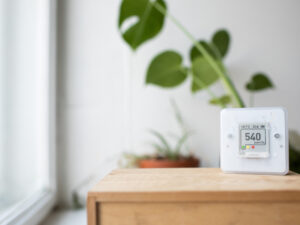
Creating a Clean & Comfortable Workspace: Strategies for Improving Indoor Air Quality
Indoor air quality (IAQ) is a critical aspect of workplace health and safety. Poor air quality can lead to various health issues. These include respiratory problems, headaches, and fatigue, which can, in turn, reduce employee productivity and increase absenteeism.
To create a clean and comfortable workspace, it’s essential to understand the sources of indoor air pollution and implement strategies to mitigate these risks.
Common Sources of Indoor Air Pollution
Indoor air pollution in the workplace can originate from various sources, many of which are often overlooked. Understanding these sources is the first step in improving IAQ.
Building Materials & Furnishings
- Volatile Organic Compounds (VOCs): Emissions from building materials, such as paints, adhesives, and sealants, are a significant source of VOCs. These compounds can cause a range of health issues, from eye irritation to long-term respiratory problems.
- Furniture & Carpets: Many office furnishings and carpets release VOCs over time, particularly when they are new. Formaldehyde, a common VOC, is often found in pressed wood products and can contribute to poor indoor air quality.
Cleaning Products
- Chemical Cleaners: Many commercial cleaning products contain harsh chemicals that can release harmful fumes into the air. These chemicals can contribute to indoor air pollution, especially in poorly ventilated areas.
- Fragrances & Air Fresheners: While these products are often used to create a pleasant-smelling environment, they can introduce synthetic chemicals into the air, contributing to indoor pollution.
HVAC Systems
- Dust & Mold: Over time, heating, ventilation, and air conditioning (HVAC) systems can accumulate dust, mould, and other contaminants. If not regularly maintained, these systems can circulate polluted air throughout the workplace.
- Inadequate Ventilation: Poor ventilation can lead to the buildup of pollutants indoors. This is because it prevents the exchange of stale indoor air with fresh outdoor air.
Office Equipment
- Printers & Copiers: Office equipment like printers and copiers can emit ozone and other pollutants during operation, contributing to indoor air pollution.
- Electronic Devices: Computers, monitors, and other electronic devices can also release small amounts of VOCs and other pollutants.
Strategies for Improving Indoor Air Quality
Improving indoor air quality requires a combination of proactive measures and ongoing maintenance. Here are some practical strategies to enhance IAQ in the workplace:
Choose Low-VOC Materials
When selecting building materials, furnishings, and finishes, opt for products labelled as low-VOC or VOC-free. These products release fewer harmful compounds into the air, helping to maintain a healthier indoor environment.
Use Eco-Friendly Cleaning Products
Replace traditional chemical cleaners with eco-friendly alternatives that are free from harsh chemicals and synthetic fragrances. Look for products certified by reputable organisations that ensure they meet specific environmental and health standards.
Maintain HVAC Systems
Regularly inspect and maintain HVAC systems to ensure they are functioning properly. This includes cleaning or replacing air filters, checking for mould growth, and ensuring that ducts are free from dust and debris. Properly maintained HVAC systems are crucial for effective ventilation and air circulation.
Increase Ventilation
Improving ventilation is essential for reducing indoor air pollutants. Ensure that the workplace has adequate ventilation, whether through natural means (like opening windows) or mechanical systems. Consider installing energy-efficient ventilation systems that provide a continuous supply of fresh air without compromising energy use.
Implement Air Purification Systems
Invest in high-quality air purifiers that can remove airborne particles, VOCs, and other pollutants. Consider air purifiers with HEPA filters, which are highly effective at capturing fine particulate matter.
Monitor Indoor Air Quality
Regularly monitor the IAQ to identify potential problems early. Use air quality sensors to track levels of pollutants, humidity, and temperature. Adjust as needed to maintain a healthy indoor environment.
Apex Environmental’s Comprehensive Air Quality Assessment Services
Apex Environmental offers specialised air quality assessment services designed to create a cleaner, healthier workplace. Our approach combines both qualitative and quantitative techniques to profile and characterise contaminated air quality and movement dynamics within your facility.
Our services adhere to the highest standards, including:
- ASHREA Standard 62: This standard provides guidelines for ventilation for acceptable indoor air quality, ensuring that workplaces have sufficient fresh air circulation.
- HSG 258: This guide to local exhaust ventilation helps in assessing and designing ventilation systems to effectively remove contaminants at their source.
- ACGIH Industrial Ventilation Manual: This manual offers best practices for designing and maintaining industrial ventilation systems to minimise exposure to harmful substances.
Compliance with Regulations
Our assessments are conducted in compliance with key regulatory requirements, including:
- Regulation for Hazardous Chemical Agents, Regulation 12: This regulation focuses on the maintenance of control measures, particularly mechanical supply and extraction systems, to ensure they effectively manage hazardous substances.
- Environmental Regulations for Workplaces, Regulation 5: This regulation addresses ventilation requirements in indoor spaces, emphasising the importance of maintaining air quality to protect employee health.
Apex Environmental’s assessments not only help you meet these regulatory requirements but also provide actionable insights for improving your indoor air quality. By identifying potential sources of pollution and assessing the effectiveness of your current control measures, we help you create a safer and more comfortable work environment.
Conclusion
Creating a clean and comfortable workspace starts with understanding the sources of indoor air pollution and implementing strategies to reduce exposure to harmful substances. By choosing low-VOC materials, using eco-friendly cleaning products, maintaining HVAC systems, and increasing ventilation, you can significantly improve indoor air quality.
Also, regular monitoring and air purification systems can further enhance the health and comfort of your workplace.
Apex Environmental’s comprehensive air quality assessment services provide the expertise and tools needed to assess, monitor, and improve indoor air quality. By adhering to industry standards and regulatory requirements, we ensure that your workplace not only meets legal obligations but also fosters a healthy and productive environment for all employees.








